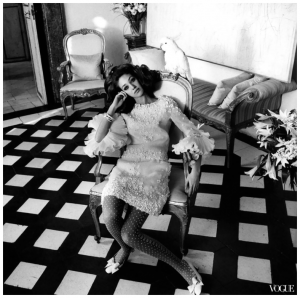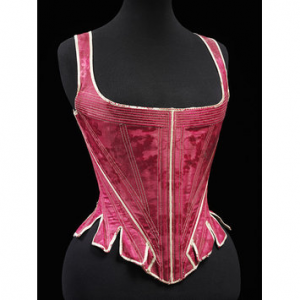Author Archives: Poppy Cordon
Task 9/10 – Ethics
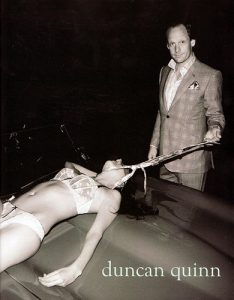
Duncan Quinn, (2008), Advert [ONLINE]. Available at: https://www.trendhunter.com/trends/duncan-quinn-suit-ad-depicting-strangled-woman [Accessed 4 December 2017].
Investigating him as an individual I found that Dunncan Quin is portrayed as no different from the man in the photograph even in the ‘About’ section in his own website ‘He’s also been known to throw the occasional party, indulge in the odd cheeky lunch, drive too fast and enjoy life just a little too much in the company of his friends’ this suggest he’s a stereotypical ‘womaniser’ that shares the same male chauvinistic views as portrayed through his advert.
The advertisement shows the disturbing image of a young attractive woman, in nothing more than her underwear, being dragged, by a tie around her neck, across a car bonnet, as if she were no more than a sex object, by a well-dressed man in a suit. The expensive looking suit and pocket square handkerchief suggest he’s a wealthy man and the sports car gives the notion that he’s accustomed to an exciting and expensive life style. The man’s blatant eye contact with the camera suggests he’s proud of what he has done, and he has no problem with the act of dehumanizing women as no more than an object of his amusement and sexual arousal. ‘no we are not merely lifeless mannequins that can be fucked or positioned however you please’ states Namata Sherinah from her article on ‘The Sexual Objectification of Women in Fashion Media: A Contemporary Cultural Perspective’.
As you can see in this photo the woman’s face is hidden and out of view so as to give her no identity or power and the almost lifeless stance as the tie is pulled taught around her neck almost suggests that she has no will of her own and is being completely dominated by the male figure pulling her towards him. This antiquated and stereotypical portrayal of male dominance over obedient women is old-fashioned and should play no part in today’s society. Any attempt at its reprisal – such as advertising campaigns like this – should be squashed instantaneously.
However, with quotes like ‘Sexy is fashion. If it is not arousing and sexual, it’s off vogue.’ doesn’t help the feminist cause. This quote suggests that to gain the public’s attention and to sell magazines women need to be seen showing some skin or be in a sexual pose as like in this advert.
Whilst many may agree with this statement I believe that the very fact that there’s an uproar every time the fashion industry is seen dehumanizing women proves that society doesn’t agree or support this notion and our society, whilst celebrating the differences between men & women, still strives to achieve a more balanced and ethical approach to gender equality.
Bibliography:
Sherinah, N, ‘The Sexual Objectification of Women in Fashion Media: A Contemporary Cultural Perspective’, Available from: http://www.kas.de/wf/doc/kas_21095-1442-2-30.pdf?161206174939
http://duncanquinn.com/
Task 7/8 – Reflective Writing
Within this chapter taken from Fashion as Communication by Malcolm Barnard it discusses the meaning of the word fashion and what it takes for a garment to be considered ‘fashion’. It starts off with the Etymology of the meaning of the word to help gain a better understanding of the subject and then graduates towards ‘social hieroglyphics’ and about how we judge people on what they wear and how we choose to be perceived.
Barnard states that ‘Fashion and clothing, that is, may be the most significant ways in which social relations between people are constructed, experienced and understood’ (Barnard 1996) which taking into account many different factors is partly true as people are well known to judge someone’s personality on what they wear as we ourselves mostly reflect how we would like to be perceived through our clothes/appearance. James Laver makes a similar point which backs this up as he believes ‘the purpose of clothes for women has been to make them more sexually attractive and the purpose of men’s clothes has been to enhance their social status’ (Laver 1969). Laver discusses how throughout time we as humans have predominantly chosen our partners by the clothes they wear as it reflects their wealth, class, and persona which have all been important deciding factors throughout history.
It also goes on to discuss how fashion can only exist in the world if there are two things ‘The first of these tendencies is the need for union and the second is the need for isolation’ (Simmel 1971) this suggest that in order for fashion to exist we have to want to socialise and be a part of a group but don’t want to all be the same as we like to express our individuality through our choice of clothing and accessories. ‘We want to look like our friends but not to be clones’ (Wilson 1992a;34).
Some may agree with Barnard that ‘while all clothing is an adornment, not all clothing is fashion’ (Barnard 1996) whilst some may argue that ‘Not all fashion is an item of dress; as noted, some fashion involves changing the colour or shape of the body’ (Barnard 1996). For me I feel that fashion is everything changeable about a person as it reflects who you are as a being or who you wish to be perceived as due to your choices of how you wear, style or change something about your appearance.
To conclude, I believe in many ways that the views Barnard puts across within his book have merit and I agree that we as a society dress and carry ourselves in a way of putting across who we are as a person or who we would like to be perceived as and that fashion is more than just the garments we chose to wear but the many changeable aspects about ourselves to make us unique and individual.
Bibliography:
Laver, J. (1969) Modesty in Dress, Boston: Houghton Mifflin Co.
Simmel, G. (1971) Individuality and Social Forms: University of Chicago Press.
Barnard, M. (1996) Fashion as Communication: Routledge, London.
Task 5/6 – Visual Research
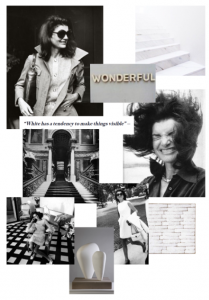
Mood board of inspiration for Valentino’s exclusive one-off Haute Couture Collection ‘Sala Bianca 945’
Valentino’s exclusive one-off Haute Couture Collection to celebrate the opening of their new flagship store on Fifth Avenue was inspired by Valentino Garavani’s iconic 1968 white collection from which Jackie Kennedy chose her wedding dress to marry Aristotle Onassis. It was also inspired by the work of Robert Ryman, a famous painter in the 1950’s and 60’s from which his work with painting white on white in a minimalistic style shot him to fame.
The photo I chose was taken by Henry Clarke for vogue 1968 and features Maris Berenson leisurely sat in a delicate white organza Valentino dress, stylish tights and elaborate white bow top shoes. The model is surrounded by a few well selected & positioned pieces of antique French style furniture, minimal lines and elegant lilies. The laid-back pose of the model suggests boredom or perhaps a level of comfort to her luxurious surroundings, which puts across the feeling that she’s used to an expensive and decadent lifestyle. The use of the white pet cockatoo, diamond jewels and flamboyant hair give a very old Hollywood glamour vibe which fits with the style vogue was trying to put across within that era. The sharp contrasting carpet with its distinct black lines, frame the image and create a distinctive crisp backdrop on which the image is built.
The seated image of the woman is central to the image, which is traditionally framed by the surrounding minimalistic room.
The high angle of the camera suggests the feeling of imposing, as if being a fly on the wall within a wealthy apartment. The open door and positioning of an empty chair behind the model could symbolise waiting for someone to arrive or exasperation of someone having departed. Overall the visual effect of the photograph is well balanced, elegant, simplistic and yet striking.
Bibliography:
Mhairi Graham, (2014) AnOther, Avalable from: http://www.anothermag.com/fashion-beauty/4185/the-inspiration-behind-valentino-haute-couture (accessed 25/11/2017)
Linda Sharkey, (2014) INDEPENDANT, Avalable from: http://www.independent.co.uk/life-style/fashion/news/valentinos-white-haute-couture-collection-9918175.html#gallery (accessed 25/11/2017)
Task 3/4 – Academic Integrity
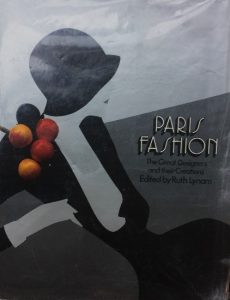
Lynam, Ruth (1972) Paris Fashion, The Great Designers and their Creations, London; Micheal Joseph Ltd
Within this book it documents the many different fashion houses within Paris in the late 19th century and how today’s generation are following more of the ‘ready to wear’ fashion rather than bespoke couture garments that were once very popular amongst the wealthy, upper-class.

Marie Claire (2015) A Brief History Of French Fashion available from: http://www.marieclaire.co.uk/fashion/a-brief-history-of-french-fashion-34032 (Accessed 25th of October 2017)
I then found a Marie Claire article on the history of French fashion where it discusses the rise of Paul Poiret from an apprentice to an umbrella maker, to one of the most influential designers within Paris history who banished the corset. The article talks about many different influential couture designers throughout the 19th century within Paris such as Elsa Schiaparelli who developed the wrap dress and made the zipper into a fashion statement not just a way of fastening a garment. Chanel is also featured within this article, as many of her designs were revolutionary and paved the way for other designers to push the boundaries of the fashion world. It talks about how she incorporated Jersey fabric within her designs and how at the time this was very controversial as Jersey was only used for men’s underwear.
Being that my last two sources discussed Haute Couture and its designers I thought it would be interesting to read about how the industry has changed throughout the years. I found a news article written by the telegraph about how the industry of couture could be dying out as the popularity of ready to wear garments are rising. There’s one quote from one of Jean-Louis Scherrer’s colleague where he describes the effort and cost to making a dress and the price that he managed to sell it for ‘over half a mile of gold thread, 18,000 sequins, and had required hundreds of hours of hand-stitching in an atelier. A fair price would have been £50,000, but the couturier could only get £35,000 for it’.
Task 1/2 – Online Resources
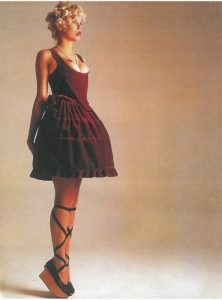
Photo taken from the book: Krell, G (1997). Vivienne Westwood (Fashion Memoir). unknown: Thames & Hudson.
Firstly, I looked within the university library at the section for famous fashion designers and found many books about Vivienne Westwood’s life and collections where she pushed the boundaries of the fashion world and incorporated unusual and shocking aspects within her work. I found this photo from her Harris Tweed collection which features a red velvet corset and mini-crini with her famous rocking horse shoes. It was within this collection that Westwood revived the corset and other 19th century garments as perhaps a symbol of sexual empowerment to prove that the corset is no longer seen as the symbol of women’s oppression.
This then drew me to look into the history of corsets where I found a similar one featured in Vivienne Westwood’s collection. The photo features a ‘Stay’ which is a corset style undergarment with straps which was most popular within the late 1700’s and were worn to accentuate the waist and shape the petticoat of the gown to the proper silhouette. Within the description of the garment there’s a quote from a letter written by the Duchess of Devonshire in 1778 where she complains that a similar corset to this one cut into her body and upper arms, ‘But it is the ‘ton’ [fashion]; and pride feels no pain.’ Which further cements the idea that corsets aren’t worth the pain if the 20th century doesn’t demand them.
I later found an article linked to this image on the V&A website discussing the reappearance and disappearance of the corset throughout the years and why designers would want to bring the corset back when its physically oppressive and associates with women’s inferior status. It discusses how originally Proiret banned the corset in 1909 as a statement and replaced the fashion with the focus on the shoulders which later evolved into the bi-dimensional dresses associated with the 1920s.
It then later came back into fashion in the 1930’s when the waist was rediscovered as the focal point of dresses after popular movies such as ‘Gone with the Wind’ and ‘Little Woman’ made Victorian style dresses popular again which featured small waistlines only achievable by wearing a corset underneath.
Since then many designers have tried to recreate the slim and smooth waistline that the corset creates with padding, boning and different cuts. The most famous being the ‘Bar’ suit designed by Dior which closely resembles the exaggerated hourglass silhouette of a corset.
It was only in the late 1970’s did Vivienne Westwood release the Harris Tweed collection revolutionizing the corset again which spurred other designers to do so, such as Jean-Paul Gaultier and Thierry Mugler where they exaggerated the garment and made it into some sort of futuristic armor. Since then the corset has never comeback fully as the pain and rigidness discourages the general public from accepting this historic garment back into today’s fashion.
Bibliography:
Unknown. (unknown). Stays. Available: http://collections.vam.ac.uk/item/O13864/stays-unknown/. Last accessed 26th Oct 2017.
Georgiana Cavendish, Duchess of Devonshire (1778). The Sylph. 2nd ed. unknown: T. Lowndes.
Unknown. (unknown). The Corset in Late 20th-Century Fashion.Available: http://www.vam.ac.uk/content/articles/t/the-corset-in-late-20th-century-fashion/. Last accessed 27th Oct 2017.
Krell, G (1997). Vivienne Westwood (Fashion Memoir). unknown: Thames & Hudson.

